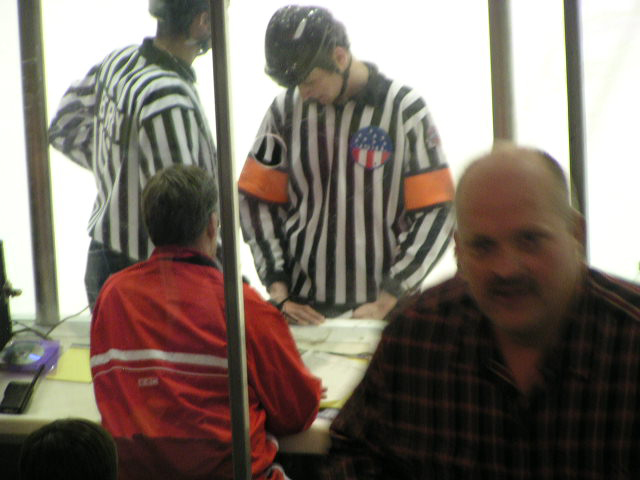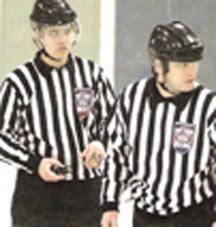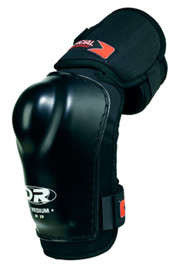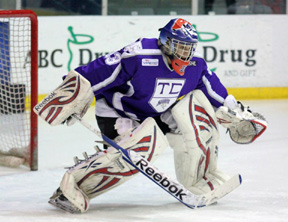Referees
And in the beginning (about 1917) there was just one Referee to officiate at
hockey games. No Linesmen, no Goal Judges, etc. Just the Referee. No striped
shirt. He wore a white sweater and dark pants. He was allowed to have an
Assistant but one was rarely used. If there was an Assistant, he wore a blue
sweater and dark pants.
The whistle had not been invented yet so the Referee carried a bell. The
first whistles were made of steel which would stick to the Referee’s lips so
they continued to use the bell. Besides, they said, the players were not as
inclined to attack them if they were carrying a heavy bell.
Finally after nine years of trying to maintain order by himself, it was
determined that the Referee should have a Linesman to assist him.
Today in the NHL, and occasionally in the USHL, a two-Referee system is
used. This is not a new idea. It was done in the mid-1930’s also. But then
it was dropped in favor of a Referee and two Linesmen. There were no referee
schools or training camps until the mid 1940’s so former players were hired
to “call them like they saw them”.
Rule 502. Referee
(i) If, through misadventure or sickness, the Referee and/or Linesmen
appointed are prevented from appearing, the Managers or Coaches of the two
teams shall agree on a Referee and Linesmen. If they are unable to agree,
they shall appoint a player from each team who shall act as Referee and
Linesman; the player of the home team acting as Referee, and the player of
the visiting team as Linesman.
From USA Hockey Official Rules; Junior Hockey Edition 2003-2005 Seasons
 |
The USHL is an entry level
for the referees as well as the players. On some rare
occasions when an unusual situation arises, it is a good idea to
consult the rule book, even during a game. |
Knowing the Rules
Have you ever stopped to think about the game from
the ref’s point of view?
The referee has to know the rule book for the USHL conference from front to
back.
But many of these refs move from one conference to another during a season.
We’ve known that several of our USHL refs also work NAHL games, for
instance. And then there is the
AHL and the NCAA, etc.
Not only must a ref know the standard rules of the game but each conference
has some rules that are different from other conferences.
According to one ref, Al Stensland, who has worked in five different
conferences over the past 10 years, the first thing he does when scheduled
for a new conference, is go through their rule book and highlight rules that
are different. Then he reviews
the differences before working the game.
Attempts have been made to standardize the rules.
The problem comes when considering the differences in abilities and
expectations, for example, between a 10-year-old who only plays in his own
arena and a 22-year-old student playing on a scholarship in college.
Looks
like the refs will have to keep their highlighter handy for a while longer.
from “Different Rulebooks” by Matt Nilles, USA Hockey, Dec. 2007
Referee Equipment
Helmets
 |
If a hockey
player decides to make the switch to referee, it is not necessary to buy all
new equipment. Take the helmets for example. They are the same. But if the
player was using a cage, a half shield will have to be substituted. And
if the helmet got a little scruffed up during games or practice, there is an
inexpensive solution. As one equipment company advertises:
“Tired of
your helmet looking dull, the NEW Officials Wearhouse helmet shine will keep
your helmet looking bright game in and game out. This small black Plastic
case fits easily in your bag and has a screw-off lid that holds a sponge
applicator containing silicone-based polish to shine your helmet.”
|
Elbow pads
These are important pieces of equipment for the referee. They
prefer a thinner, more stream-lined pad instead of the bulkier player pad.
That is probably why we are not aware that they are being worn under that
striped shirt.
|
 |
Shin Guards
 |
The referee and linesmen may wear shin guards if they wish. This
piece of equipment closely resembles the player’s shin guard. Since
they are worn inside the trouser leg, the fan in the audience cannot
tell if the officials are wearing this protection. |
|

